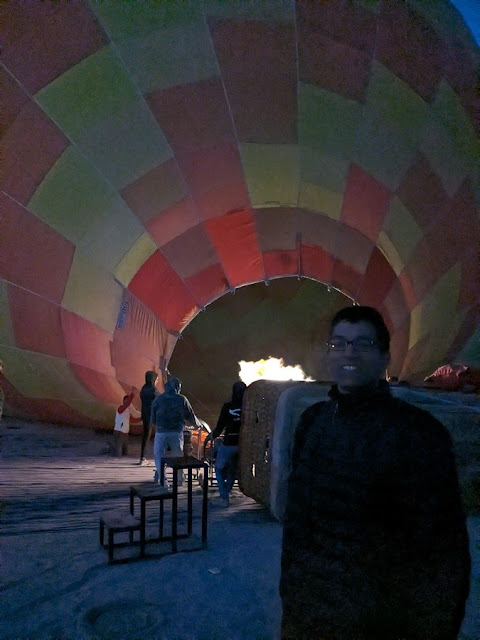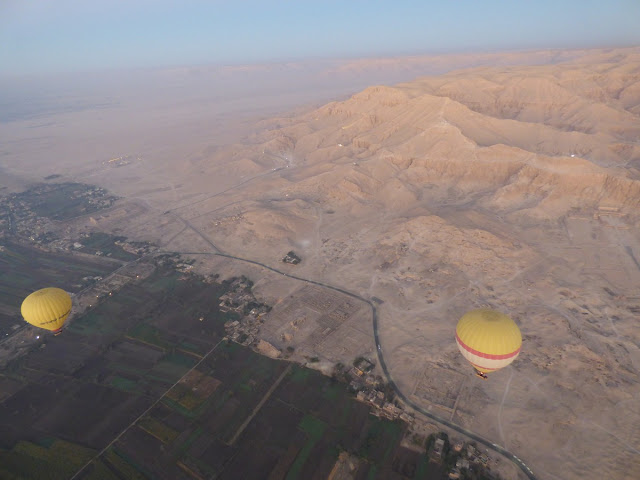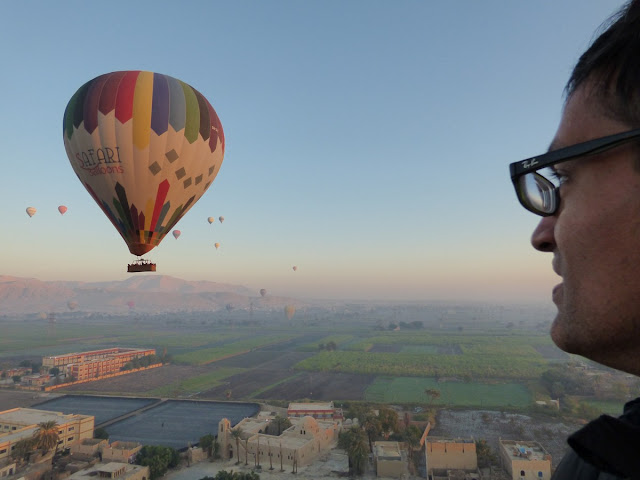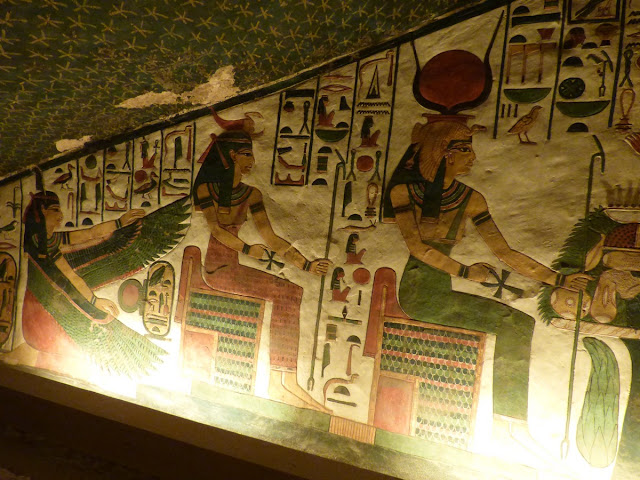Day 9 Saturday Dec 2
Sunrise Hot air balloon ride, back to apt at 7am for breakfast, Valley of Queens at 8am, Deir el Bahri, Hutshepsut, Tomb of Nobles
Sunrise Hot air balloon ride
we had scouted around for options, Saleem balloons was 55usd pp, suggested by our apt owner and we booked.
they picked us up at 4.30am and drove us to a place where we transferred to another van which had other customers already in.
then we were driven to the spot where the balloons take off.
it was lovely seeing the balloons getting pumped with air ready for take off.
our balloon was smaller compared to the one we had ridden in Cappadoccia Turkey... just 4 compartments with 3 customers in each. the height of the balloon compartment was also a little less, I found it easier to jump in after climbing the ladder [it was easier to hoist myself up when disembarking as well]
up in the air it was great to see the rest of the balloons
The Nile was gleaming like a silver ribbon down below
our captain Abdo here
The Israeli girl who was in our compartment took this pic [yes, an Israeli tourist in Egypt after the breakout of hostilities; she said which country she's from when she talked to the Captain in Arabic and he asked her! ]
Sunrise was beautiful... streaks of red followed by the golden yellow ball peeping through the horizon.
we saw Ramesseum, Hatshepsut, the Colossi quite clearly from above, along with lush fields of sugar cane and modern houses
we landed smoothly after taking the crouch position as instructed. in Turkey that had not been necessary.
Here, the captain was pretty good. the ground crew were a motley lot. In Cappadoccia the captain had a helper and a walkie talkie and landed on a truck precisely. Here the captain operated alone, the balloon dragged through some fields getting yelled at by the farmer! [cost 35usd in Turkey, 55 usd here. beauty of landscape was incredible in Turkey comparatively. anyway this had been enjoyable as well]
Valley of Queens
we were dropped back at our apartment after the balloon ride. We had our breakfast, we had asked our car to come at 7.30 . We went to the Valley of Queens
there are some more pics in our earlier post covering our 1st visit to the same tomb
below is the same scene as above, Queen is making her offerings. Ma'at kneels with outstretched wings, extended to shield the queen's cartouche, attached to which is a shen-sign. Se;ket and Isis are sitting on chairs
can also see djed pillar with arms. In each hand it holds a was-sceptre. there is a winged uraeus cobra. This protects the queen's cartouche and a shen-sign with its wings, in the same way as Ma'at before it. The cartouche sits on a the hieroglyphic "nebu-sign" for gold
Four square section pillars support the large ceiling, two each in the higher end sections, leaving the central area clear. Those on the east are separated from those on the west by two small flights of steps, leading into and out of the lower middle area.
The sides of the pillars facing onto the axis from the entry stairway to the rear of the chamber, marking the deceased's journey from religious "east" to "west", are all decorated with mummiform images of Osiris. In each case he faces towards the entrance of the chamber, as if to welcome Nefertari.
We visited Nefertari tomb again
QV 66, NEFERTARI 19th Dynasty (1295-1255 B.C)
She was the beloved Great Royal Wife (GRW) of Ramesses II, one of the best known of the Egyptian queens, next to Cleopatra, Nefertiti and Hatshepsut. Her tomb, QV66, is the largest, most lavishly decorated and spectacular in the Valley of the Queens.
Ramesses II also constructed for her a temple at Abu Simbel, next to his own colossal monument. He even made the size of her statues, on its facade, to the same scale as his own. "For whom the sun shines" is a unique inscription from the façade of her Temple at Abu Simbel.
She married Ramesses at age of thirteen, who was himself only fifteen, before he became pharaoh. She was the most important of his eight wives for at least the following twenty years. She died sometime during the 25th regnal rear of the reign of Ramesses and the reason for her death remains uncertain.
Although she had at least four sons and two daughters, none of these succeeded to the throne. The heir to the throne of Ramesses II was Prince Merneptah, his 13th son by another wife, Isetnofret.
Her tomb is entered via an flight of eighteen steps this is the antechamber
THE ANTECHAMBER
The chamber, which is almost square (5.2m north-south by 5.0m east-west and 3.2m in height), is approximately 3.0m below the ground level of the entrance. The fact that is excavated into the limestone hillside, means the roof of the chamber is well below the actual surface of the hill.
The area is divided into two registers, a picture register at the top and a totally text register below.
All of the small scenes of the upper register relate to Chapter 17 of the Book of the Dead
The Queen playing senet
In her right hand she holds a sekhem-sceptre. She is engaged in playing a game of senet, considered as a forerunner of the modern game of checkers.
The game frees her spirit in the form of the human-headed ba-bird, to travel outside the tomb during the day. The text inside the canopy identifies her as: "The Osiris, the king's great wife, mistress of the two lands, Nefertari beloved of Mut, justified with Osiris the great god"
THE EAST WALL [Pic below]
The middle of the eastern wall of the antechamber is interrupted by a wide opening. The scene on the right begins on the eastern side of the south wall, up to the entry stairway; this represents Nefertari's entry and welcome to the afterlife by two divinities (Osiris and Anubis).
On the left side of the wide entry to the next chamber is a representation of Osiris. The large opening leads to the vestibule, which in turn leads into the first eastern annexe.
The architrave above the opening is decorated with eleven serpents (rampant uraei) alternating with nine blue ostrich plumes, facing outwards from the kneeling god or genie at the centre. The god, who is not named, spreads his hands over two ovals containing udjat-eyes.
in the left of pic, scene shows Nefertari being introduced, by the goddess Isis, to the god Khepri, who has the head of a scarab beetle. Isis wears the sun-disk on her head between curved bulls horns, from the front of which hangs a uraeus
in the right, the south wall and the adjoining section of the east wall form a similar scene to the one at the north end. This time it is Horus, son of Isis who leads Nefertari, and they approach two seated deities, Ra-Horakhty and Hathor.[The texts above them provide their identities.]
The three short texts in front of the two deities state that they promise Nefertari: "a place in the sacred land, a lifetime as long as that of Ra, and eternity with life, stability and dominion".
On the lintel above the entry to the next chamber is an image of the vulture goddess Nekhbet. Her name appears twice, at either end of outstretched wings. In her claws she holds the symbol of protection, the "shen-sign"
Below is a representation of Chapter 148 of the Book of the Dead. None of the actual text from the chapter is shown here, just names of the participants. The scene actually extends onto the adjoining first section of the west wall, where Nefertari stands in adoration.
In the top two registers of the south wall there are seven cows and a bull (bottom left), each standing behind a small offering table, not intended for the animals but for the nourishment of Nefertari.
in the bottom register are the steering oars which help Nefertari manoeuvre among the stars. With Ra serving as the helmsman and the oars propelling her pilgrimage, none of Nefertari's enemies will know her or even recognise her, (or so the full text promises). Each oar is linked with a cardinal compass point.
in the nearby wall in the corner Nefertari is requesting that the cows provide her sustenance: "I have come before you, my Lord Ra. I will cause the seven cows and their bull to flourish. May you grant bread and beer, offerings and provisions for my spirit, and grant that my soul may be with you".
[more pics of this and other walls in prior post:
SECOND STAIRWAY
Facing Nefertari, ready to receive her offerings, are three goddesses: Isis; Selket with scorpion on her head [on right side it's Nepthys]; and Ma'at. The first two are seated on the now common chairs, whilst Ma'at kneels with outstretched wings, extended to shield the queen's cartouche, attached to which is a shen-sign.
All three goddesses have their distinctive emblems on their head, and the seated ones each hold a was-sceptre and ankh-sign.
Their usual style dresses alternate in colour, red, green and red, giving variety to the scene.
Below, both sides of the same scene can be seen
Goddess Khepri is standing
Below: Goddess Ma'at [justice, cosmic harmony] [daughter of Ra, and Hathor , Consort of Thoth] with ostritch feather on her head, spreading her wings on the lintel.the side wall upper part belonging to Anubis, and below to Isis. The left-hands sides of both of these two levels is filled with columns of hieroglyphic texts belonging to the respective images. Sample 'I have given you a place in the necropolis so that you may appear gloriously in heaven like your father Re. The realm of the dead is illumined by your radiance. May your heart be forever joyous' ".
full view of the stairscan also see djed pillar with arms. In each hand it holds a was-sceptre. there is a winged uraeus cobra. This protects the queen's cartouche and a shen-sign with its wings, in the same way as Ma'at before it. The cartouche sits on a the hieroglyphic "nebu-sign" for gold
BURIAL CHAMBER
The chamber is 10.4m south-north and 8.2m east-west. The ceiling height at the two ends is approx. 3.0m. Nefertari's red granite sarcophagus originally stood in the lower centre section, however, only a part of the lid was found at the time of the discovery of the tomb.
these 2 columns show a large djed pillar, a symbol associated with both Ptah and Osiris, the god of the underworld. Its shape is thought to be inspired by the human spine and had the meaning of 'stability'.
Djed pillar
Nefertari's passage through the gates of Chapter 144 of the Book of the Dead begins immediately on turning left when entering the burial chamber. It continues along the left side of the chamber until reaching the entry of annexe in the middle of the rear wall, her ritual western horizon, the place of Osiris.
Although always called "gates", in Nefertari's tomb they are shown in all cases as a red rectangle surrounded by an ochre framing, by their color convention they in fact represent a door (red representing wood) with a stone (ochre) framing; so "gate" is really perhaps "gateway" or "entry gate".
1st gate
Preceding each gate, the words spoken by Nefertari are given in several columns written in retrograde hieroglyphs. That is, that although they look from the actual glyphs as though they should be read from right to left, they are in fact to be read from left to right.
The gate is immediately followed by the three named attendants, identified as male or female by the colour of the skin; the male is always red-brown and the female is a pale skin-tone.. Each group consists of, firstly, two animal-headed (the first is always ram-headed) then a human-headed attendants. They are: the doorkeeper, who holds a leafy branch in the right hand and a knife in the other; the guardian, who holds a knife in each hand; and the herald or announcer, who holds an ankh in each hand. Nefertari must speak the name of each gate and the name of each attendant, in order to be able to pass through
eg, "The first gate. The name of the doorkeeper is 'Downward of face, numerous of forms';
the name of the guardian is 'Eavesdropper' (literally: 'the burning of the ear') ;
the name of the herald is 'Loud of voice'.
pic below: Nefertari has at last completed her journey and stands before Osiris, with two of his companions. She is also once again complete, because the four sons of Horus have protected her internal organs.
Osiris is shown closest to Nefertari, but slightly overlapped by Hathor, who is overlapped by Anubis who is shown in full.
Osiris wears his white mummiform garment with the long red sash tied around the waist. He holds a crook and flail in his hands, his symbols of power, and wears the atef crown on his head.
Hathor, dressed in the normal tight fitting red dress, rests her left hand on the shoulder of Osiris. She holds her right hand open, palm uppermost, above her knees. On her head, secured by a red sash, she wears the symbol of the "west".
Finally, Anubis, jackal-headed, wears his pleated gold kilt over a plain white one and a green tunic on his upper torso. In his right hand he holds a ankh sign, whilst he rests his left on the left shoulder of Hathor.
The text at the top of the scene identifies the four participants.
The pillars were cut in-situ, from the natural rock, before being plastered and decorated. A short flight of steps leads down between the first pair into the lower central area of the chamber; and another short flight leads upwards between the northern pair, to the northern annexe.
All four faces of each were decorated
With the exception of the south facing surfaces of pillars 1 and 2, which have priests, the six faces all contain images of Nefertari facing a god (once only, Anubis) or a goddess (Isis, three times, and Hathor, twice)
priest with his right arm raised, as if to point the way to the rear of the chamber, the sacred "West".
QV52 Queen Tyti 20th Dynasty, wife and sister of Ramesses III
and possibly the mother of Ramesses IV
Low ceiling in the sarcophagus room
Amunherkhepeshef tomb QV55
Amun-her-khepeshef was the eldest son and appointed heir of Pharaoh Ramesses III. He died when he was about fifteen years old
Report continues
https://adventuretrav.blogspot.com/2024/02/egypt-diy-trip-nov-22-dec-11-2023_27.html




















.png)
.png)



















































No comments:
Post a Comment